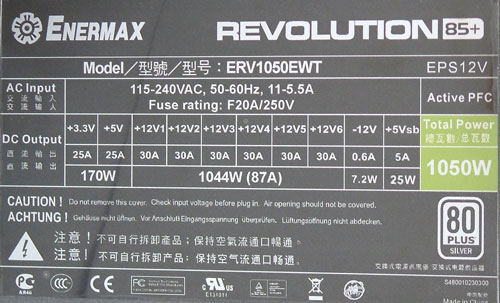Enermax Revolution 85+ High Efficiency PSU
by Christoph Katzer on November 6, 2008 4:15 AM EST- Posted in
- Cases/Cooling/PSUs
Introduction
We first received a sample of the Revolution 85+ about two months ago. Enermax was going to launch the product much earlier, but a sudden change in plans created some delays. During the past couple weeks, we've had a chance to play around with final hardware, which has been quite fun. There are some new innovations inside this PSU, and in fact the inside looks totally different from what we've seen in the past. Enermax now includes DC-to-DC circuitry to create all of the lower voltage rails, something normally done with a transformer. DC-to-DC technology is nothing new since we've already seen it in several other units, but the approach Enermax took isn't quite the same as other vendors, which we will see later. Note that some of the images for this article come from Enermax marketing, including photos of the packaging material since that wasn't ready in time for this review.

The appearance of our first sample was similar to previous tested models like the Infiniti or Galaxy. In fact, this power supply was originally going to be branded Galaxy 2 before Enermax chose the Revolution moniker. The original came in a gunmetal color with a golden fan-grille installed over the huge 135mm fan; all of that changed with the latest version, which will finally hit the market.
In typical Enermax fashion, the company equipped this power supply with a massive modular cabling system that can satisfy pretty much any need. Some critics will say that modular cables can cause problems with high-performance power supplies, but during testing Enermax still manages to reach very high efficiency with stable voltages.
The Revolution 85+ series comes in four different wattages: 850W, 950W, 1050W, and 1250W -- although the last will only be available for 230VAC (i.e. Europe). Today we will be looking at the 1050W model, the ERV1050EWT. The feature list is impressive, with six 12V rails, no-load operation (which will be important for future hybrid power GPUs), power saving modes for upcoming CPUs, high efficiency, and all outputs rated at 50°C.

The six 12V rails are each rated at 30 amps, although Enermax has almost certainly set the OCP a little higher, i.e. 35 amps. There is more than enough power to connect the most demanding graphics cards, a highly overclocked processor, plenty of hard drives, and still have room to spare. 12V1 delivers power to the 24-pin ATX connector; 12V2 powers both the 4/8-pin and 8-pin EPS connectors; 12V3 is for the first and second graphics card connectors; 12V4 handles the first 12-pin socket and peripheral sockets 1, 2, and 3; 12V5 gets the second and third 12-pin sockets; and last, 12V6 is for the fourth 12-pin socket and the remaining peripherals. The distribution is very good and nobody should experience any overloads with today's hardware. The 3.3V and 5V are both rated at only 25A, although this is still more than sufficient for modern systems. The standby 5V rail is stated at 5A, which is massive compared to many other power supplies, but it's necessary in order to comply with the EPS12V regulations in version 2.92.










49 Comments
View All Comments
strikeback03 - Friday, November 7, 2008 - link
You should have stated you were using a 700W power supply, your post indicated you thought you were drawing 700W.http://www.anandtech.com/casecoolingpsus/showdoc.a...">http://www.anandtech.com/casecoolingpsus/showdoc.a...
I have a similar system on my desk here at work (only 3 GHz on the q6600, but it is a B3 stepping; 2 HDD, 1 optical, 7300GT instead 0f 9800GX2) and idle is about 100 W at the wall, peak draw is like 160-170. Your system probably draws another 120-150W at idle, and maybe 250 at full power. A 700W power supply is quite reasonable for that system, as it probably uses 200-250 at idle and another 150-200 at full bore. It won't draw 700W.
Freddo - Thursday, November 6, 2008 - link
This PSU is so cool, as it's very energy efficient & have modular cables.I would really like to see a PSU as energy efficient as this one, but down at ~400W or so instead, and with passive cooling, or at least "half passive", with a small 80mm fan outwards that only starts to spin when it's near full load and getting hot.
Christoph Katzer - Thursday, November 6, 2008 - link
Wait until next year's ~CES/CeBIT, there is a manufacturer who might have exactly what you're waiting for...iwodo - Thursday, November 6, 2008 - link
As Anand as well as other tech site has confirm, even with GTX SLI and Quad Core CPU, you will hardly need more then 500W, lets give it a peak spike of 40% will only means 700W.So why are we having PSU that starts at 800W? When only less then 5% of market uses it. Not to mention 1000W PSU.
Shmak - Thursday, November 6, 2008 - link
All power supplies reach their efficiency peak at about 50% load, which is shown on any psu review you care to look at. Therefore, if your system idles at around 500W, a 1000W psu will likely be most efficient for your build.GaryJohnson - Thursday, November 6, 2008 - link
Watts don't mean anything. What matters is having enough stable amps on a couple (or single) 12v rails to power SLI or Crossfire.OddJensen - Thursday, November 6, 2008 - link
Try a Core i7 w/HD4870X2 in crossfire. You'll soon find out why we have 1kW PSUs.larson0699 - Thursday, November 6, 2008 - link
How about a Pentium D or Skulltrail with quad GTX 280's?Do like the small jets and shut off everything else before powering up THOSE engines.
Nigel.k.l - Tuesday, November 26, 2019 - link
I purchased mine back in 09 and its still running, I7 8700k 1070ti system